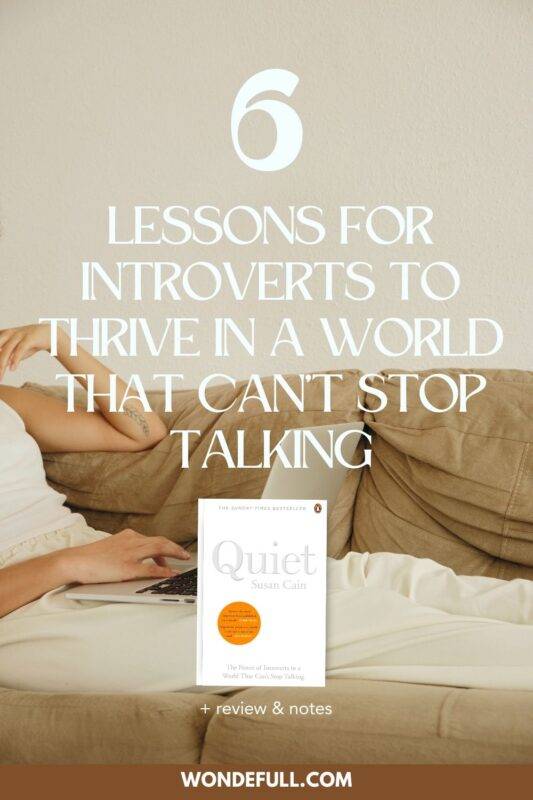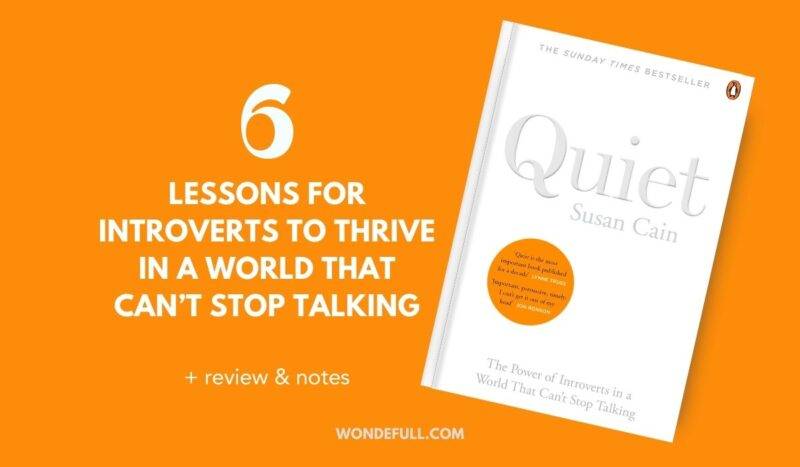What is Unique About This Book
It is a must-read book for introverts that helps them learn more about themselves through scientific findings and famous introverts’ life stories. It also helps introverts leverage their quiet strengths to manoeuvre and achieve their goals in this extrovert-ideal society.
How I Discovered It
I watched Susan Cain’s TED talk many years ago and this book has always been on my to-read list. I bought the physical book two years ago but only managed to read two chapters. Now that I have a Kindle, I finished the book in two weeks.
Who Would I Recommend This Book
🟢You are an introvert who wants to learn more about yourself
🟢You want to communicate better and have better relationships with introverts
6 Key Lessons from This Book
1. Introverts aren’t shy
Introversion-extroversion is not about shyness; it’s a preference for certain levels of stimulation. As an introvert, I can socialize in a 10-person gathering at home, but I find a 100-person party in a club with loud music overstimulating and causing anxiety. My optimal stimulating level for an environment is lower than that of extroverts and some other introverts.
Understanding this allows me to consciously situate myself in environments favorable to my personality. In a 100-person party, I can retreat to a quieter corner and engage in small talk with 2-3 acquaintances rather than facing a crowd of strangers—this is how I find my “sweet spot.”
Being in environments within our “optimal levels of arousal” or “sweet spots” is crucial to making us feel more energetic and alive. While I now set up my environments, work, hobbies, and social life to spend as much time inside my sweet spot, I occasionally introduce novelty. This helps desensitize me and stretch beyond the outer limits of my temperament.
2. Introverts are born
This book reveals that introversion-extroversion is 40 to 50 percent heritable, derived from a twin study. This means that, on average, half of the variability in introversion-extroversion in a group of people is caused by genetic factors. The truth is, nobody knows how much of your introversion might be inherited from your parents—your introversion could range from 0 to 100%.
As we grow up, our personalities become more influenced by environmental factors. This is why many of our extroverted friends tend to become less extroverted as they age. This transformation includes my best friend, Jess, who now identifies as an introvert based on the MBTI test. Her shift is attributed to the overstimulating work environment she has been in for the past four years.
Knowing that genes contribute to my introversion and I have the free will to change it soothes me. I can preserve the advantageous aspects of my introverted temperament and improve on some aspects, such as overcoming the fear of public speaking, being too sensitive and overthinking.
However, how much can we change our personality? According to Schwartz’s research in Chapter 5, we can stretch it only up to a point. A few months ago, I was attending social gatherings every week and faced burnout. Thanks to the prefrontal cortex, I know I can self-soothe when novelty appears. However, I would never be able to shut down my highly reactive amygdala.
Understanding that we cannot change our personality infinitely beyond our genetic limits frees us from trying too hard to be like my extroverted peers. I have wholeheartedly embraced who I am and ceased attempting to mould myself into someone I am not—a process that caused me significant pain and anxiety.
3. The world needs introverts’ strengths
According to the Theory of Evolution, traits and characteristics are eradicated when deemed unfit for survival. However, why does the high sensitivity of introverts, which leads them to dislike public speaking and small talk, persist, making at least half of society introverted?
In Chapter 6, the book provides multiple examples demonstrating that both the “bold/aggressive/fast” type and the “shy/sensitive/slow” type are essential for the survival of animal communities and human society. The former excels at hunting for food, while the latter performs better in farming, selling goods, and education.
Fast-forwarding to modern society, this example is again illustrated in the partnership between the charismatic Franklin D. Roosevelt, who possessed savoir-faire, and the sensitive Eleanor Roosevelt, who reminded him of social conscience. This dynamic ultimately led to FDR becoming the only president elected four times.
The significant contribution of introverts to society should not be dismissed. What is it about introverts that makes them excel in certain areas where extroverts may not? Here is a comparison of the strengths and weaknesses of introverts and extroverts derived from Chapters 6 and 7.
| Introvert | Extrovert |
| Less reward-sensitive | More reward-sensitive due to a stronger response to dopamine |
| Thin-skinned, avoiding the limelight | Thick-skinned, comfortable in the spotlight |
| Persistent and possess a higher tolerance for delayed gratification | Crave more for immediate satisfaction |
| More conscientious, empathetic to others feelings | Less sensitive and more result-focused |
| Keen observers and prudent thinkers who are aversed | Bigger risk taker and act fast |
| More direct and find it harder to tell lies | Charismatic and can fake enthusiasm easier |
| Tend to be philosophical or spiritual, dislike small talk | Enjoy socialising with huge groups of people and thrive in a wide range of topics |
| Better at complex problem solving as they think more carefully | Perform better under time or social pressure or involving multitasking due to their better handling of information overload |
Extroverts’ buzz and limitless energy propel them to take risks and achieve goals. However, when this becomes overwhelming, society may suffer, as demonstrated by the 2008 financial catastrophe. The upper echelons were increasingly occupied by ambitious and risk-taking individuals, sidelining introverts like Vincent Kaminski, who had warned about the Enron scandal.
This is not meant to denigrate extroverts nor to glorify introversion. Instead, it signifies the importance of maintaining a balance between introversion and extroversion in various scenarios, particularly in critical decision-making. Striking a balance between action and reflection is essential.
4. Introverts can thrive in an extrovert-ideal society
Look at your surroundings—from schools to workplaces—who are the popular and well-liked ones? I bet they are extroverts who are comfortable putting themselves out there. They confidently articulate their opinions and ideas and love mingling around. Extroverts voice out before introverts, who think more before they speak; of course, they are going to get attention first.
According to a Stanford Business School study, verbal fluency and sociability are the most important predictors of success. The world favors confident and expressive extroverts. More and more gurus aspire to teach us to be more charismatic. Does it mean that introverts are doomed? The answer is no.
The success of Warren Buffett, Eleanor Roosevelt, Bill Gates, Mark Zuckerberg, and many more introverted leaders has demonstrated that introverts could be leaders as well. They are passionate about their ideas and share them persistently with the world. But how do they do it? All of them are firm in pursuing the truth and refusing to divert energy to unnecessary skirmishes along the way. Mahatma Gandhi gave this trait the name satyagraha. But perseverance in one’s conviction is not enough if we do not share it with the world. So Warren Buffet took a Dale Carnegie course, put on a pseudo-extrovert mask, and made a public warning about the technology companies bubble in July 1999, which came true the following year.
The Free Trait theory says that introverts are capable of acting like extroverts as long as it is for the sake of anything they value highly. In the book, the author gives an example of an introverted Professor Little who also needs to lecture in front of an entire class. After each lecture or between talks, he would find alone time to recharge himself to prepare for the next extroverted event. Introverts can mimic this approach by setting up “restorative reserves” to recharge their energy in preparation for extroverted events.
To survive and thrive in the environment, I learned that introverts need to find core personal projects that we deem meaningful, manageable, and not unnecessarily stressful, and are supported by others. I can stretch my personality to advance work I care about deeply, but once it is done, I’m returning to my introverted self to recharge.
#5 Introverts need to find their own voices
Introverts are usually cerebral and reflective, with active brain activities that might not be evident in their calm exterior. Suppressing thoughts and feelings can be draining, so introverts need to learn how to express themselves at appropriate times.
Other than putting on a pseudo-mask for the cause we care deeply about, we can also convey our ideas and opinions through other non-verbal methods, such as writing, arts, videos emails, and slide presentations. Collaborating with extroverts can also be an effective way to share ideas.
Contrary to the common belief that performers are typically extroverted, many artists and content creators are introverts. What sets them apart is their ability to find unique ways to express themselves through their performances. For introverts, the key is to honour their individual styles rather than conforming to prevailing norms.
#6 Introverts don’t want to be alone all the time
We crave companionship and intimacy. The stereotype that extroverts are pro-social and introverts are antisocial is wrong. Humans belong to the community, every one of us wants to find a sense of belonging somewhere.
The degree of extroversion seems to influence how many friends you are, but not the quality of relationships. Introverts crave deep connections which is challenging to maintain with many people at the same time. So, it is natural that they don’t have as many friends as extroverts but it does not mean that they want to be a loner.
As introverts and extroverts each makeup about half of society, we must know how to communicate with the opposite types. The truism that ‘we have two ears and one month and we should use them proportionately’ teaches us to be active listeners and voice out our feelings and thoughts at appropriate times.
My Review of Quiet and Personal Takeaway
I took quite a long time to write this book review and notes because “Quiet: The Power of Introverts in a World That Can’t Stop Talking” is packed with so many golden nuggets. If you want to explore the concepts in more detail, you must read the book. Some areas that I did not cover include parenting introverted children and the comparison of East introversion vs. West extroversion.
I appreciate how well-researched “Quiet” is, filled with scientific references and insights from great minds, offering many far-reaching lessons. The book liberates me from attempting to be an extrovert, a goal unattainable due to genetic limits. I used to envy extroverts, as they receive recognition and compliments faster and more frequently than us. However, after reading this book, I no longer see them as threats because I have learned about introverts’ quiet strengths.
Instead of focusing on what I lack, I should appreciate what I have and learn how to leverage it. The persistence virtue of introverts allows me to dive deep and go very far on my personal development journey. With a clearer sense of my identity, I am now more objective and open-minded, ready to learn from other perspectives, including those of extroverts.
Overall, it is a book that is worth revisiting once in a while, especially if you are an introvert seeking to make an impact on the world and live a more interesting and contented life.

If you want to buy this book, you are most welcome to use my link. If it’s not for you, feel free to check out other books in book notes!
Like this book review and notes? Share it on Pinterest – thank you!





